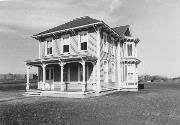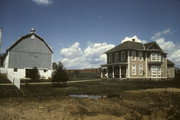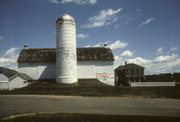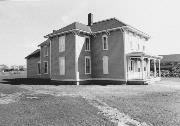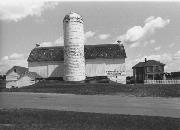| Additional Information: | A 'site file' exists for this property. It contains additional information such as correspondence, newspaper clippings, or historical information. It is a public record and may be viewed in person at the Wisconsin Historical Society, State Historic Preservation Office.
Description: Clapboard is the exterior fabric on this two story Italianate farm house. The plan is basically rectangular. The main part of the house has a hip roof, the back section has gabled roofs. All endboards are pilasters. The cornice is boxed and a plain frieze is under the eaves. A water table is at the bottom of the wall. Most windows are 2/2 and have frames with slightly pitched triangular entablature heads. Brackets are on the front sections of the porch and bay window. On much of the house there are two paired brackets, two single smaller brackets, and then paired brackets again.
The front has three symmetrically placed 2/2 windows on the second story. There are four paired brackets and three sets of single brackets between them under the eave. Two more windows are on the first story on the south part, directly below the second story windows. The entry is at the north edge. The single door has sidelights (blocked) and an arched transom window with an entablature head. A one story full front porch has a hip roof and a box cornice. Single brackets are under the eave, one over each porch column. The frieze has a rectangular pattern between brackets. Porch columns are of sawn and turned wood. They have square wood bases and capitals. Sawn wood scrolls are at the top. There are four symmetrically placed columns and two pilasters. To the north of this main section is an ell that has one 2/2 window on each story. A paired bracket is at the wall edge and two smaller ones are south of it.
The south side has two 2/2 windows on each story of the west part. Three paired brackets with two single ones between are under the eave. East of this is a two story bay window on a narrow (one foot) ell that has paired brackets at the top. At the top of the bay is a pedimented gable dormer with a plain frieze. The bay has a shingled pent roof between the stories. There are single brackets (three to a side and two at the back edges) under the eave and a plain frieze. Rectangular pattern woodwork is on the base of the bay window. East of this is a second story 1/1 window without a triangular head. Below this is a new window. East of this is a 1 1/2 story section with a gable roof. This has a door with a shed roof over it and one window.
The east or rear section has an exterior door and a 2/2 gable window on the one story section. To the south of this section (on the second story part) is a small first story window.
The north side of the building has a 2/2 gable window on the one story section. The 1 1/2 story section west of this has two 2/2 windows on the second story and and one on the east part of the first story. West of this is a door with the same triangular head as the windows. An ell that is formed with the second story section of the house has a paired bracket and a single bracket on the east side. The center section (ell) has paired brackets on each end and two large brackets over the second story window. Two of the smaller brackets are between these. The first story has a 2/2 window. To the west on the main body of the house is a second story window that is narrow and has a semicircular entablature head. The exterior window is rectangular but the interior one has an arched glass pane. Below this is a shuttered window of the same size.
There are four barns or outbuildings and two silos left on the property. Only a chicken coop has been torn down. Northwest of the house is a gambrel roof barn and concrete silo. A small gable roof shed is attached to this building on the northeast. The eave faces the road on this building and the silo is on the west side. Three buildings with gable roofs (gable to road) are scattered on the property east of this, as is another silo. Patches of concrete and old fences are in this area. Weeds have grown up between the buildings. These buildings are in fair condition, most damage done by neglect, not misuse.
The house has retained its original integrity. It has been moved because it was threatened with destruction. The distance moved is short (within 500-1000 feet) and in no way diminishes the the integrity of the house.
Significance: This is an outstanding example of an Italianate farm house. There is none that comes near it in excellence in the city or neighboring areas. The bracketing, window details, front porch, and bay window combine to produce an aesthetically pleasing structure. It is significant on a local level as a representation of the Italianate style.
History: Marcus Sears Bell built this farmhouse in 1884. He was born in Newhall, New York on Feb. 19, 1844. Robert and Elsie Newkirk Bell were his parents. The family was from Vermont and Ohio. In 1860 he was in St. Croix County. For about four years Bell worked with James Johnston. They broke running teams and had a threshing machine venture. Bell was nicknamed "Doc" after being named after a family friend who was a doctor.
Bell bought 120 acres of land in Richmond township, south of the city, in 1869. This had been Levi and Tim Oakes' property. He also bought property at Third Street and Dakota Avenue. On July 4, 1870, Bell and Katherine Johnston, a sister of James, were married. They lived in the city in the Third Street and Dakota Avenue house (gone) until the farm was built. Bell would buy more property to add to his farmland holdings until he had 320 acres.
Bell was the last village president in 1884. At this time he moved onto his farm just south of the city. In April of 1885 New Richmond incorporated as a village. In the mid-1890s Bell moved back into the city. The Wisconsin State Gazetteer lists him as a cattle breeder one mile south of the city in 1895-6. He built a house at 350 West First Street (see SC 20/5). His son Ernest lived on the farm. In 1899 Bell was on the post-tornado building committee. He lost 8-10 residences and 3-4 stores in the storm. When he died in 1904, he was a first ward alderman and member of the school board. He was also a member of the Old Settlers' Association of St. Croix Valley and the Methodist Episcopal Church. He was reported to be one of the largest real estate owners in the city when he died. His obituary called him "conservatively progressive." This is also an excellent description of much of the town's character and architecture.
Katherine Johnston Bell was born in 1849. She was one of nine children. Her parents were David and Catherine (Gregg) Johnston of North Ireland. The family emigrated to Canada in 1835 and Katherine was born there. Her father was a lumberman. In 1856, the family was in Hudson and in 1857 they moved to a farm in Hudson Prairie. They stayed there until 1861 when they bought 160 acres in Richmond township. Mr. Johnston retired and let his sons manage the farm. William and James were partners in a lumbering operation. William lived on West First Street near Marcus and Katherine (see SC 20/10, 425 West First Street, and SC 20/9, 467 West First Street).
Before her marriage Katherine was a school teacher. The Bells had four children. Bertha was a preceptress at Hamline University who later married Dr. E.N. Tuckey of Syracuse University. Maud and Mollie were twins born in October 1880. Ernest J. Bell lived on the farm and was also president of B&W Concrete Company in New Richmond. Mrs. Bell and the twins moved to 425 West First Street (see SC 20/5) sometime after Marcus died.
The local newspaper reported on 12/19/1883 that Bell was hauling materials for his farm. By 6/4/1884 the frame of the house was up and it was noted, "it is near enough to be claimed in town." In July the house was almost done and Bell had to resign his village post. It was not until the last year this area was annexed into the city.
Although this farm is interesting for its association with the Bell family there are no historical events or people that would give this building significance. It is not closely tied to the development of the city.
A rear one-story screened porch on the north facade with a flat roof fell off when the house was moved in 1982 and sat on blocks for two years. It was not original to the house as built in 1884. |
|---|

